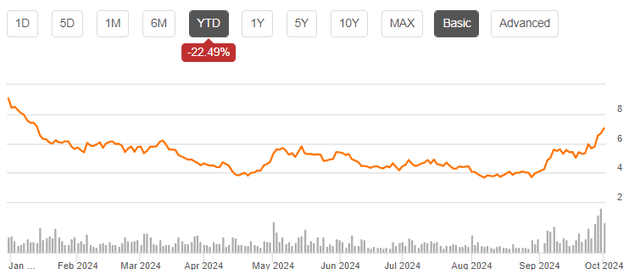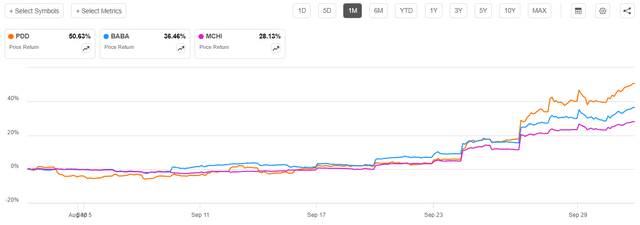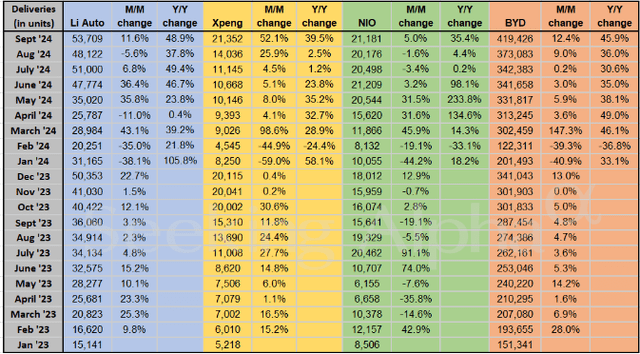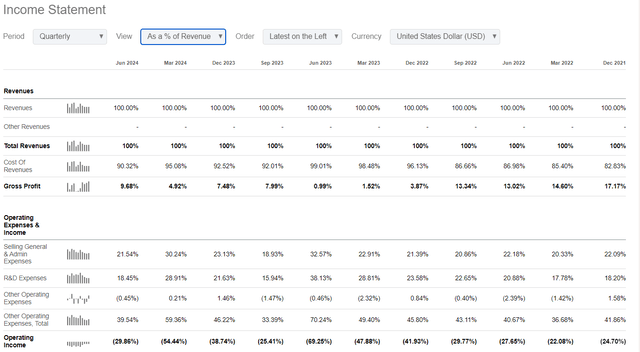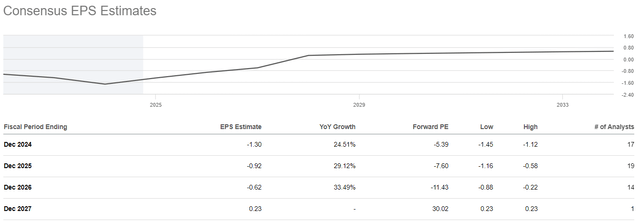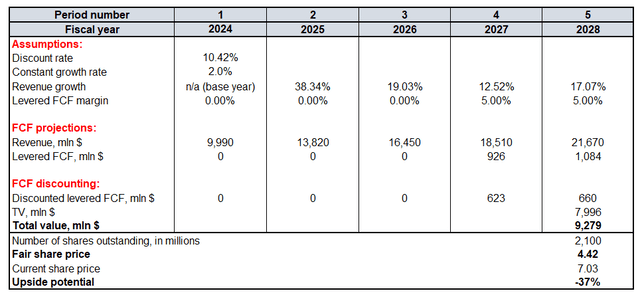Summary:
- NIO’s September rally appears speculative and driven by FOMO, with the stock now overbought and overvalued, prompting a ‘Strong Sell’ recommendation.
- Despite a 58% surge since July, NIO remains deeply unprofitable with a deteriorating balance sheet and unimpressive Q3 deliveries compared to rivals.
- NIO’s operating margin improved YoY, but is still weaker than 2021-2022 levels; the net cash position sheet shrank by $1.7 billion YTD.
- My DCF model indicates NIO stock is 37% overvalued, with a fair share price of $4.42, and 86% of its value tied to post-2028 cash flows.
Andy Feng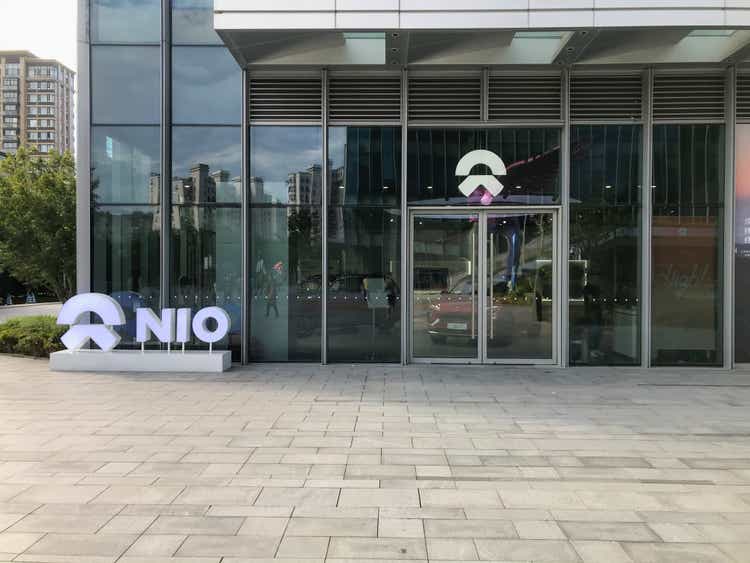
Introduction
It might seem that I was wrong with my pessimistic opinion about NIO (NYSE:NIO). The stock surged by 58% since July 2 when my previous article was published.
This does not look well, but my analysis suggests that NIO’s September bull run was more likely speculative and fundamental. Speculative and FOMO-driven rallies are rarely sustainable. I prefer to focus on fundamentals, and I see that NIO is still deeply unprofitable, its balance sheet is deteriorating rapidly, and fresh Q3 deliveries numbers are not impressive compared to rivals. Moreover, the stock is now overbought and overvalued. Therefore, I reiterate a ‘Strong Sell’ recommendation for NIO.
Fundamental analysis
Despite the recent share price spike, we see below that NIO is still 22.5% down YTD. The stock started surging in late August when the stock traded below $4. NIO’s last close was at $7, meaning that there was a massive rally during September 2024.
There were several positive catalysts for the stock price, but I want to emphasize the one that was not specific catalyst related to NIO. September was quite bullish overall for all Chinese stocks, which we can see from the below performance demonstrated by the iShares MSCI China ETF (MCHI). As we see, the ETF gained 28% during September, which is explained by tailwinds related to governmental stimulus for the economy. Major Chinese stocks like Alibaba (BABA) and PDD Holdings (PDD) also rallied massively over the last month.
After I have emphasized that the significant part of NIO’s share price spike is explained by the overall improved sentiment around Chinese stocks, I can delve into recent developments which will be specific to NIO.
The most fresh information about NIO is its Q3 2024 deliveries. According to the release, NIO delivered 61,855 vehicles in Q3, increasing by 11.6% YoY. To add context, I am also sharing the information about Q3 2024 deliveries of Li Auto (LI) and XPeng (XPEV). LI’s Q3 deliveries were at 152,831 units, increasing by 45.4% YoY. XPEV delivered 46,533 units in Q3, which was up 16% on a YoY basis. As we see, NIO is once again significantly behind its closest Chinese EV rivals. This is a red flag suggesting that NIO’s offerings are less compelling compared to peers.
The picture also does not look good for NIO compared to rivals if we look at September sales only. NIO’s both MoM and YoY growth in September 2024 was behind not only LI and XPEV, but also trailed BYD (OTCPK:BYDDF). I would also like to emphasize that NIO has the smallest scale among four players, and lagging in terms of growth means that the gap in absolute terms will continue to widen as well.
Another portion of investors’ optimism around NIO in September was the company’s Q2 earnings release. The company missed revenue consensus estimates and its bottom line is still deeply negative, but the stock spiked by around 30% the week after the earnings release. Such an optimism was likely explained by the significant YoY improvement of the operating margin, from -69% to -30%. Such an improvement might indeed be impressive, but the below screenshot suggests that it is not the best operating margin delivered in the company’s history. Therefore, I do not share such an optimism in respect of the operating margin.
Moreover, NIO’s balance sheet continued deteriorating during Q2. The below dynamic suggests that NIO’s net cash position has shrunk by around $1.7 billion since the beginning of 2024. Tangible book value per share has tumbled by around 70% YTD, and we see that it is not explained by the dilution as the outstanding shares count was approximately flat.
SA
The stock appears to be extremely overbought after the September rally. Its 75 RSI indicator is close to the levels of 2020-2021 when there was a stock market craze and NIO traded at around $60 per share. I think that the combination of several red flags and being overbought is a strong indication that the share price is likely to go down.
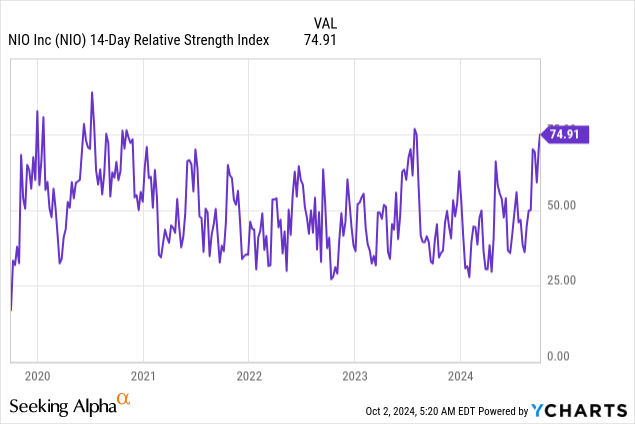
To conclude, I see no reason to become bullish about NIO. Its financial position is still deteriorating rapidly and is poised to maintain this trend as the P&L’s bottom line is still deeply negative. Despite the solid operating margin improvement, it is still weaker than levels demonstrated by the company in 2021 and 2022. Last but not least, we see that NIO’s Q3 deliveries figures are notably behind rivals, meaning that its products are less appealing.
Valuation analysis
The discounted cash flow model appears to be the only way to value a deeply unprofitable company like NIO. Cost of equity is the discount rate, and Gurufocus suggests that it should be 10.42%. From the fresh information about deliveries volumes, we see that NIO is unable to compete and its DCF model unlikely deserves constant growth rate above 2%. Revenue assumptions are from consensus.
Consensus EPS is expected to hit positive only in 2027. Therefore, I also do not expect the FCF margin to become positive earlier than 2027. For 2027 and 2028 I incorporate a rule of thumb 5% FCF margin. According to Seeking Alpha, there are 2.1 billion NIO’ shares outstanding.
My DCF model suggests that NIO is 37% overvalued. The fair share price is $4.42, but I want to also emphasize that out of a total $9.3 billion fair value, almost $8 billion represents terminal value. This suggests that around 86% of the business’s fair value comprises cash flows that will be generated after 2028.
Mitigating factors
As I have mentioned in the very first sentence of this article, my previous bearish recommendation did not age well. The stock benefited from positive news around all Chinese stocks, and only a portion of the rally is explained by some positive company-specific factors. We see that NIO is an extremely volatile stock and can demonstrate a 50% upswing over just a month. Since my DCF analysis suggests notable overvaluation and there are several fundamental weaknesses, I expect the stock to plunge. But it does not mean that there will not be sudden spikes that we saw in September.
Some positive news might include partnerships with some large legacy automotive companies like Volkswagen (OTCPK:VWAGY), which has a strong presence in China. Or the company’s rich investor from Abu Dhabi might inject a couple of billion more to improve the company’s financial position. This potential news might lead to new bull runs.
Conclusion
I think there are no fundamental reasons to be less bearish about NIO. The September rally looks more speculative rather than fundamental, and the stock now is overbought and overvalued.
Editor’s Note: This article discusses one or more securities that do not trade on a major U.S. exchange. Please be aware of the risks associated with these stocks.
Analyst’s Disclosure: I/we have no stock, option or similar derivative position in any of the companies mentioned, and no plans to initiate any such positions within the next 72 hours. I wrote this article myself, and it expresses my own opinions. I am not receiving compensation for it (other than from Seeking Alpha). I have no business relationship with any company whose stock is mentioned in this article.
Seeking Alpha’s Disclosure: Past performance is no guarantee of future results. No recommendation or advice is being given as to whether any investment is suitable for a particular investor. Any views or opinions expressed above may not reflect those of Seeking Alpha as a whole. Seeking Alpha is not a licensed securities dealer, broker or US investment adviser or investment bank. Our analysts are third party authors that include both professional investors and individual investors who may not be licensed or certified by any institute or regulatory body.

